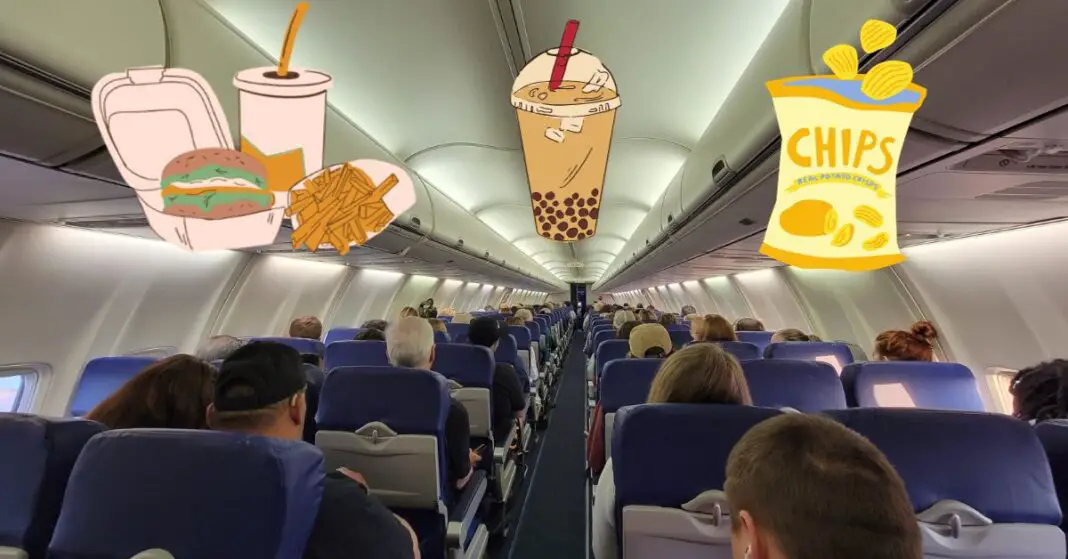Embarking on a journey and wondering about the snacks from home? Our blog dives into the question, “Can you bring food on the plane from home?”
Unveiling the ins and outs of airline regulations, this guide provides valuable insights to help you pack your favorite treats for a delightful and stress-free travel experience. From TSA rules to smart packing tips, discover how to satisfy your in-flight cravings without any hassle.
Table of Contents
Does TSA allow you to bring food through security?
We’re all admittedly used to packing easy-to-grab, pre-packaged snacks for those lengthy plane rides, aren’t we? But there’s no denying that there’s something profoundly comforting about nurturing your family with your homemade food, even when you’re thousands of feet up in the sky.
Nevertheless, going through airport security with homemade food might seem like an uphill task that has you second-guessing your decision. Don’t fret, though, the rules regarding carrying homemade food aboard a plane are not as intimidating as you might imagine, and with a dash of planning, you can easily navigate airport security.
To travel with home-cooked meals, the most critical point you have to remember is that the Transportation Security Administration (TSA) differentiates between solid and liquid food items. This is pivotal as it directly determines the kind of screen a particular food item would go through.
Solid food items like sandwiches, cakes, or hard cheese can be packed in your carry-on bag. Good news indeed for those of us who want to give our kids the wholesome nutrition of homemade meals while on a journey. TSA officers may instruct you to separate these items from your carry-on bag, so it might be helpful to have them packed in a way that makes it easy to take them out.
Liquid or semi-liquid food items like jellies, gravy, or creamy dips are subject to the 3-1-1 liquids rule, which states you’re allowed to take small containers of liquids, gels, aerosols, creams, and pastes through security, provided they do not exceed 3.4 ounces each and that they all fit within a one-quart clear zip-top bag. Items that don’t comply with this rule can be packed in your checked-in luggage.
Ensuring that your homemade food items are compliant is crucial, but at the same time, keep them appetizing. Sandwiches should be securely wrapped to prevent them from becoming squished. Fruit should be sliced or cored as required, ready to be eaten. Busy travelers do not need the extra step of having to cook things up!
Even with these rules in place, remember that TSA officers have the final say on what can be permitted on a plane. If an officer determines that a particular food item is deemed a security risk, they have the power to disallow it. So, be prepared for this possibility, no matter how small the chance.
Ideal Foods and Packing Tips
Keeping family nutrition in mind while packing for air travel often brings to mind a host of questions. Striking a perfect balance between food safety, convenience, and the scrumptiousness of homemade food can indeed be a daunting task, but with a few smart tips, it can be managed without much strain.
One critical tip to keep in mind is knowing which types of homemade food fare well in air travel conditions. The journey is likely long, and conditions in the overhead bins or under the plane seat may not be conducive for all types of edibles. Robust fruits like apples, pears, and oranges make for great travel snacks. They are hardy, refreshing, and require minimal packaging. Dried fruits and nuts are also excellent choices due to their nutrient density and non-perishable nature.
Granola bars, trail mix, and popcorn can be made at home without much difficulty and tend to stay fresh throughout the journey. Homemade bread, pastries, or cookies, if packed properly, can complement your fruit and nut mix well and keep your family full longer.
To keep these items fresh, consider investing in good-quality food storage containers. Airtight containers or vacuum-sealed bags prevent air and moisture from getting in and spoiling the food. If your travel itinerary includes a mealtime, consider packing a salad: veggies hold up well while traveling. Just remember to pack the dressing separately and stick to the 3-1-1 liquids rule!
On the more savory side, solid protein sources like hard-boiled eggs and grilled chicken or turkey strips make the journey nicely when packed into a sturdy container. Cheese cubes, awesome for pairing with some artisanal bread, can give you the right amount of creaminess without falling foul of TSA’s liquid rules.
Remember, these suggested food options are not just about satiating hunger pangs mid-flight, but also about creating enjoyable and wholesome food moments with your family. Therapeutic aspects of familiar homemade food can be a bonus during a potentially stressful journey.
Advantages and Challenges of Carry-On Food
Traveling can be a joy, but it isn’t without its struggles. For many, the challenge comes when deciding what to eat while in the air. With a little forethought, bringing homemade meals on a plane can be a viable and ultimately satisfying alternative to most on-flight food options.
Continuing on the TSA guidelines explained earlier, it’s vital to remember not to bring any homemade food items that could be classified as potentially hazardous. This includes foods that require refrigeration, custard or cream-filled pastries, and canned goods, all of which could potentially be interpreted as a safety risk.
That being said, there are numerous benefits to bringing homemade food on the plane. One of which is the reassurance of knowing exactly what you and your loved ones are consuming. Homemade food allows individuals to factor in specific dietary needs, restrictions, or allergies that can offer peace of mind.
Economically speaking, it also feels good not having to splurge on expensive, often subpar airline food. Plane food has often come under criticism for its lack of freshness and nutritional value. By swapping these meals out for a homemade alternative, families can enjoy nutritious and fresh food throughout their journey.
Keep in mind watchfulness over the types of homemade food chosen for travel is an essential aspect. Ensure food items selected are not likely to spoil or become unpalatable due to changes in pressure or temperature, as these factors could affect the quality and safety of the food.
Preparation is a crucial component when traveling with homemade food. Food should be properly secured in leak-proof containers to avoid unwanted messes in your carry-on luggage. In addition, packing the food in a way that it’s easily accessible will make the in-flight dining experience more enjoyable and less of a hassle.
Let’s not forget, though, that traveling with homemade food on a plane can come with potential difficulties. It requires preparation and careful packing to ensure food items do not spill, spoil, or get squished. Additionally, not all food is practical or suitable to bring on a plane. This includes items like soups or broths, which can be tricky to pack or even prohibited by TSA regulations.
What food Cannot be taken on a plane?
Bringing food on planes has its restrictions. While most snacks and packaged items are allowed, liquids and gels over 3.4 ounces are not permitted in carry-ons. Fresh produce and meats may face restrictions in certain countries, so it’s important to check regulations.
To ensure passenger comfort, it’s best to avoid strong-smelling foods like durian, and unpacked or homemade items might raise security concerns.
Be mindful of allergies and repack bulky containers if necessary. Always check with your airline and the destination country for specific rules before packing your next in-flight snack!
Can you take home cooked food through TSA?
Bringing homemade food through TSA is easy if you follow a few rules. Use clear containers for solid dishes, freeze items with ice packs, and keep liquids under 3.4 ounces in a zip-lock bag.
Cut fresh fruits and veggies, be mindful of strong smells like durian, use sturdy containers to prevent leaks, and check import restrictions at your destination. Declare meat, poultry, or seafood if needed.
What snacks are TSA approved?
Pack pre-cut fruits, nuts, seeds, and dried fruits for a healthy crunch. Choose granola and protein bars with minimal added sugar. Crackers and pretzels pair well with cheese, nut butter, or hummus. Beef or turkey jerky provides savory, protein-rich options. Air-popped popcorn is a light, filling treat.
Single-serving yogurt pouches, hummus with veggies or crackers, and applesauce make for delicious and portable snacks. Pack in clear, resealable bags for easy inspection, stay updated on TSA regulations, and avoid strong-smelling foods for considerate travel.
Can you bring food in Ziploc bags on a plane?
Ziploc bags are perfect for packing your in-flight snacks if you keep a few things in mind. Use clear Ziploc bags for solid items like sandwiches, fruits, veggies, cookies, and chips for easy inspection.
For frozen items like burgers and meatballs, keep them solid with ice packs. Liquids and gels, such as sauces and dips, should be packed in containers under 3.4 ounces each and placed in a one-quart Ziploc bag.
Avoid bringing strong-smelling foods like durian or fish curry to ensure a pleasant environment for everyone. Use sturdy Ziploc bags to prevent leaks and double-wrap for extra protection. If you’re carrying meat, poultry, or seafood, check with customs at your destination about declaring them.
Can I bring an open bag of chips on a plane?
TSA generally permits open bags of chips in both carry-on and checked luggage. Chips are considered solid food items and are not subject to liquid or gel restrictions.





